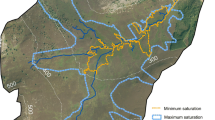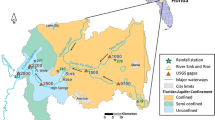Abstract
Surface water concentrations of dissolved organic carbon ([DOC]) are changing throughout the northern hemisphere due to changes in climate, land use and acid deposition. However, the relative importance of these drivers is unclear. Here, we use the Integrated Catchments model for Carbon (INCA-C) to simulate long-term (1996–2008) streamwater [DOC] at the four Swedish integrated monitoring (IM) sites. These are unmanaged headwater catchments with old-growth forests and no major changes in land use. Daily, seasonal and long-term variations in streamwater [DOC] driven by runoff, seasonal temperature and atmospheric sulfate (SO4 2−) deposition were observed at all sites. Using INCA-C, it was possible to reproduce observed patterns of variability in streamwater [DOC] at the four IM sites. Runoff was found to be the main short-term control on [DOC]. Seasonal patterns in [DOC] were controlled primarily by soil temperature. Measured SO4 2− deposition explained some of the long-term [DOC] variability at all sites.






Similar content being viewed by others
References
Ågren, A., M. Haei, S.J. Köhler, K. Bishop, and H. Laudon. 2010. Regulation of stream water dissolved organic carbon (DOC) concentrations during snowmelt; the role of discharge, winter climate and memory effects. Biogeosciences 7: 1–12.
Bergström, S. 1992. The HBV model—Its structure and applications. SMHI Reports RH no. 4, Norrköping, Sweden.
Bergström, I. 1998. The Integrated Monitoring Programme in Finland. Boreal Environment Research 3: 201–203.
Beven, K. 2006. A manifesto for the equifinality thesis. Journal of Hydrology 320: 18–36.
Christman, R.F., D.L. Norwood, D.S. Millington, J.D. Johnson, and A.A. Stevens. 1983. Identity and yields of major halogenated products of aquatic fulvic-acid chlorination. Environmental Science and Technology 17: 625–628.
Clark, J.M., H. Bottrell, C.D. Evans, D.T. Monteith, R. Bartlett, R. Rose, R.J. Newton, and P.J. Chapman. 2010. The importance of the relationship between scale and process in understanding long-term DOC dynamics. Science of the Total Environment 408: 2768–2775.
de Wit, H.A., J. Mulder, A. Hindar, and L. Hole. 2007. Long-term increase in dissolved organic carbon in streamwaters in Norway is response to reduced acid deposition. 2007. Environmental Science and Technology 41: 7706–7713.
Easthouse, K.B., J. Mulder, N. Christophersen, and H.M. Seip. 1992. Dissolved organic carbon fractions in soil and stream water during variable hydrological conditions at Birkenes, southern Norway. Water Resources Research 28: 1585–1596. doi:10.1029/92WR00056.
Eimers, M.C., S.A. Watmough, and J.M. Buttle. 2008. Long-term trends in dissolved organic carbon concentration: A cautionary note. Biogeochemistry 87: 71–81.
Erlandsson, M., N. Cory, S. Köhler, and K. Bishop. 2010. Direct and indirect effects of increasing dissolved organic carbon levels on pH in lakes recovering from acidification. Journal of Geophysical Research 115(G3): G03004. doi:10.1029/2009JG001082.
Erlandsson, M., I. Buffam, J. Fölster, H. Laudon, J. Temnerud, G.A. Weyhenmeyer, and K. Bishop. 2008. Thirty-five years of synchrony in the organic matter concentrations of Swedish rivers explained by variation in flow and sulphate. Global Change Biology 14: 1191–1198. doi:10.1111/j.1365-2486.2008.01551.x.
Forsius, M., M. Alveteg, A. Jenkins, M. Johansson, S. Kleemola, A. Lükewille, M. Posch, H. Sverdrup, and C. Walse. 1998. Magic, safe and smart model applications at Integrated Monitoring sites: Effects of emission reduction scenarios. Water, Air, and Soil pollution 105: 21–30. doi:10.1023/A:1005099930089.
Forsius, M., T. Saloranta, L. Arvola, S. Salo, M. Verta, P. Ala-Opas, M. Rask, and J. Vuorenmaa. 2010. Physical and chemical consequences of artificially deepened thermocline in a small humic lake—A paired whole-lake climate change experiment. Hydrology and Earth System Sciences 14: 2629–2942.
Futter, M.N., D. Butterfield, B.J. Cosby, P.J. Dillon, A.J. Wade, and P.G. Whitehead. 2007. Modelling the mechanisms that control in-stream dissolved organic carbon dynamics in upland and forested catchments. Water Resources Research 43: W02424. doi:10.1029/2006WR004960.
Futter, M.N., and H.A. de Wit. 2008. What controls dissolved organic carbon concentrations in streams: A comparison of empirical and process-based models. Science of the Total Environment 407: 698–707.
Futter, M.N., M. Forsius, M. Holmberg, and M. Starr. 2009. Modelling the impact of European emission and climate change scenarios on dissolved organic carbon concentrations the surface waters of a boreal catchment. Hydrology Research 40: 291–305.
Haaland, S., D. Hongve, H. Laudon, G. Riise, and R.D. Vogt. 2010. Quantifying the drivers of the increasing colored organic matter in boreal surface waters. Environmental Science and Technology 44: 2975–2980.
Haei, M., M.G. Öquist, I. Buffam, A. Ågren, P. Blomkvist, K. Bishop, M. Ottosson Löfvenius, and H. Laudon. 2010. Cold winter soils enhance dissolved organic carbon concentrations in soil and stream water. Geophysical Research Letters 37: L08501. doi:10.1029/2010GL042821.
Köhler,S.J., T. Zetterberg, M.N. Futter, J. Fölster, and S. Löfgren. 2011. Recovery from acidification at the Swedish Integrated Monitoring sites simulated with MAGIC-mass balances and sensitivity analysis. Ambio (this issue). doi:10.1007/s13280-011-0208-7.
Köhler, S.J., I. Buffam, J. Seibert, K.H. Bishop, and H. Laudon. 2009. Dynamics of stream water TOC concentrations in a boreal headwater catchment: Controlling factors and implications for climate scenarios. Journal of Hydrology 373: 44–56.
Krug, E.C., and E.R. Frink. 1983. Acid rain on acid soil: A new perspective. Science 221: 520–525.
Laudon, H., S.J. Köhler, and K. Bishop. 1999. Natural acidity or anthropogenic acidification in the spring flood of northern Sweden. Science of the Total Environment 234: 63–73.
Lepistö, A., P. Kortelainen, and T. Mattsson. 2008. Increased organic C and N leaching in a northern boreal river basin in Finland. Global Biogeochemical Cycles 22: GB3029. doi:10.1029/2007GB003175.
Löfgren, S. 2009. Integrated Monitoring of the environmental status in Swedish forest ecosystems—IM Annual report for 2007. Swedish University of Agricultural Sciences, Uppsala, Sweden (in Swedish, English summary).
Löfgren, S., M. Aastrup, L. Bringmark, H. Hultberg, L. Lewin-Pihlblad, L. Lundin, G. Pihl-Karlsson, and B. Thunholm. 2011. Effects of recovery from acidification in soil water, groundwater and runoff during 1996–2009 at the Swedish Integrated Monitoring sites. Ambio (this issue). doi:10.1007/s13280-011-0207-8.
Löfgren, S., N. Cory, and T. Zetterberg. 2010a. Aluminium concentrations in Swedish forest streams and co-variations with catchment characteristics. Environmental Monitoring and Assessment 166: 609–624.
Löfgren, S., J.-P. Gustafsson, and L. Bringmark. 2010b. Decreasing DOC trends in soil solution along the hillslopes at two IM sites in southern Sweden—Geochemical modeling of organic matter solubility during acidification recovery. Science of the Total Environment 409: 201–210.
Löfgren, S., and T. Zetterberg. 2011. Decreased DOC concentrations in soil water in forested areas in southern Sweden during 1987–2008. Science of the Total Environment 409: 1916–1926. doi:10.1016/j.scitotenv.2011.02.017.
Lundin, L., M. Aastrup, L. Bringmark, S. Bråkenhielm, H. Hultberg, K. Johansson, K. Kindbom, H. Kvarnäs, and S. Löfgren. 2001. Impacts from deposition on Swedish forest ecosystems identified by Integrated Monitoring. Water, Air, and Soil pollution 130: 1031–1036.
Moldan, F., J. Hruška, C.D. Evans, and M. Hauhs. 2011. Experimental simulation of the effects of extreme climatic events on major ions, acidity and dissolved organic carbon leaching from a forested catchment, Gårdsjön, Sweden. Biogeochemistry. doi:10.1007/s10533-010-9567-6.
Monteith, D.T., J.L. Stoddard, C.D. Evans, H.A. de Wit, M. Forsius, T. Høgåsen, A. Wilander, B.L. Skjelkvåle, et al. 2007. Dissolved organic carbon trends resulting from changes in atmospheric deposition chemistry. Nature 450: 537–541. doi:10.1038/nature06316.
Morecroft, M.D., C.E. Bealey, D.A. Beaumont, S. Benham, D.R. Brooks, T.P. Burt, C.N.R. Critchley, J. Dick, N.A. Littlewood, et al. 2009. The UK Environmental Change Network: Emerging trends in the composition of plant and animal communities and the physical environment. Biological Conservation 142: 2814–2832. doi:10.1016/j.biocon.2009.07.004.
Oni, S.K., M.N. Futter, and P.J. Dillon. 2010. Landscape-scale control of carbon budget of Lake Simcoe: A process-based modelling approach. Journal of Great Lakes Research. doi:10.1016/j.jglr.2010.05.003.
Rankinen, K., T. Karvonen, and D. Butterfield. 2004. A simple model for predicting soil temperature in snow covered and seasonally frozen soil: Model description and testing. Hydrology and Earth System Sciences 8: 706–716.
Sælthun, N.R. 1996. The “Nordic” HBV model. Description and documentation of the model version developed for the project Climate Change and Energy Production. NVE Publication 7, Norwegian Water Resources and Energy Administration, Oslo.
Tang, D., E. Lydersen, H.M. Seip, V. Angell, O. Eilertsen, T. Larssen, X. Liu, G. Kong, et al. 2001. Integrated Monitoring Program on acidification of Chinese terrestrial systems (IMPACTS)—A Chinese-Norwegian cooperation project. Water, Air, and Soil pollution 130: 1073–1078.
Vaughan, H., T. Brydges, A. Fenech, and A. Lumb. 2001. Monitoring long-term ecological changes through the Ecological Monitoring and Assessment Network: Science based and policy relevant. Environmental Monitoring and Assessment 67: 3–28.
Whitehead, P.G., M.N. Futter, and R.L. Wilby. 2006. Impacts of climate change on hydrology, nitrogen and carbon in upland and lowland streams: assessment of adaptation to meet water framework directive objectives. Proceedings of the British Hydrological Society 2006 conference meeting, 1–12. British Hydrological Society, London.
Winterdahl, M., J. Temnerud, S. Löfgren, M.N. Futter, and K. Bishop. 2011. Riparian zone influence on stream water total organic carbon concentrations at the Swedish Integrated Monitoring sites. Ambio (this issue). doi:10.1007/s13280-011-0199-4.
Yurova, A., A. Sirin, I. Buffam, K. Bishop, and H. Laudon. 2007. Modeling the dissolved organic carbon output from a boreal mire using the convection-dispersion equation: Importance of representing sorption. Water Resources Research W07411. doi:10.1029/2007WR006523.
Acknowledgments
Comments from two anonymous reviewers and the editor have greatly improved the quality of the final manuscript. The Swedish Integrated Monitoring program has been funded, since inception, by the Swedish Environmental Protection Agency. This work would not have been possible without the efforts of all the people who collected and analyzed samples from the IM sites and those who maintained the data archive. The modeling would not have been possible without Dan Butterfield’s patience and programming skills. MNF was funded by the Mistra FutureForests programme. We acknowledge the support of SCARP, the Swedish Clean Air Research Program.
Author information
Authors and Affiliations
Corresponding author
Rights and permissions
About this article
Cite this article
Futter, M.N., Löfgren, S., Köhler, S.J. et al. Simulating Dissolved Organic Carbon Dynamics at the Swedish Integrated Monitoring Sites with the Integrated Catchments Model for Carbon, INCA-C. AMBIO 40, 906–919 (2011). https://doi.org/10.1007/s13280-011-0203-z
Published:
Issue Date:
DOI: https://doi.org/10.1007/s13280-011-0203-z




